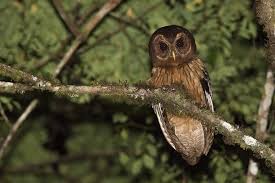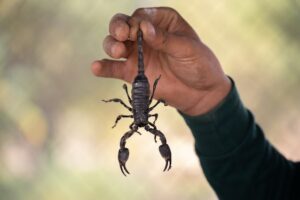Nestled within the lush rainforests and ancient Mayan ruins of Belize, a symphony of nocturnal creatures comes alive after dark. Among these is the Mottled Owl, a fascinating predator shrouded in mystery. Known for its hauntingly beautiful calls and mottled brown and white plumage that blends seamlessly into the nighttime environment, this owl is a true master of camouflage. But the Mottled Owl is more than just a silent observer. Read on to unveil the secrets of this remarkable bird, discovering its remarkable adaptability, unique vocalizations, and the vital role it plays in the delicate balance of Belize’s ecosystems.
A Master of Camouflage: Exploring the Mottled Owl’s Unique Appearance
The mottled owl’s very name hints at its most striking feature: its camouflage. Unlike some owls with bold facial discs or bright eyes, the mottled owl boasts a coat of mottled brown and white feathers. This seemingly random pattern is anything but. It’s a masterpiece of natural selection, perfectly suited to the owl’s life in the dappled light and shadows of Belize’s diverse habitats.
Imagine the mottled owl perched on a branch, its feathers mimicking the broken bark and patches of lichen. The brown tones blend with the tree trunk, while the white speckles disappear amongst the sunlit leaves filtering through the canopy. This disruptive coloration makes the owl incredibly difficult to spot for potential prey and predators alike.
But the mottled owl’s camouflage goes beyond just color. The loose, downy texture of its feathers further disrupts its outline, making it appear more like a gnarled knot on a branch than a vigilant predator. Additionally, the owl’s round head lacks the prominent ear tufts found on some owl species. This streamlined profile allows it to slip silently through dense foliage, further enhancing its ability to remain unseen.
This masterful disguise isn’t just a cosmetic trick. It’s a matter of survival. The mottled owl relies on stealth to hunt small mammals, reptiles, and insects. By blending seamlessly with its surroundings, the owl can get close enough to unsuspecting prey before launching a surprise attack.
The mottled owl’s camouflage isn’t just limited to the daytime. While these owls are primarily nocturnal, they may occasionally be active during twilight hours. Even in these low-light conditions, the mottled pattern provides a significant advantage. The interplay of light and shadow on the owl’s feathers helps it vanish amongst the fading light and emerging darkness.
In conclusion, the mottled owl’s unique appearance is a testament to the power of natural selection. From its disruptive coloration to its downy feathers and streamlined head, every aspect of its plumage is meticulously designed to make it a master of camouflage, allowing it to thrive in the vibrant yet challenging world of Belize’s nighttime ecosystems.
Versatile and Vocal: How the Mottled Owl Thrives in Belizean Habitats
The mottled owl isn’t just a pretty face (well, maybe a pretty feathered face). This adaptable bird demonstrates a remarkable ability to thrive in a wide range of Belizean habitats. From the dense jungles of the Maya Mountains to the drier scrublands of the north, the mottled owl finds a way to make itself at home.
One key to its success lies in its tolerance for human presence. Unlike some owl species that shy away from civilization, the mottled owl can be found near farms, villages, and even urban areas with scattered trees. This adaptability allows it to tap into a wider food source, finding prey in agricultural fields, gardens, and even backyards.
However, the heart of the mottled owl’s range lies within Belize’s diverse forests. Here, it reigns supreme in the nighttime hours, utilizing its excellent vision and hearing to hunt a variety of prey. From scurrying rodents and darting lizards to sleepy insects, the mottled owl plays a crucial role in keeping these forest ecosystems balanced.
But the mottled owl isn’t a silent hunter. While its camouflage allows it to blend in visually, its vocalizations play a vital role in communication and territory defense. The most recognizable sound is its haunting hoot, a low, mournful call that echoes through the night. This call serves multiple purposes. It attracts mates, warns off rivals, and helps individuals locate each other within their territories.
The mottled owl’s repertoire extends beyond the hoot. They also emit hisses, growls, and clicks, each with a specific meaning within their social interactions. These calls help coordinate hunting efforts with potential mates, maintain social hierarchies within groups, and signal distress when threatened.
The mottled owl’s adaptability extends beyond its habitat tolerance. Its diverse vocalizations and ability to adjust its hunting strategies based on its environment paint a picture of a highly intelligent and resourceful predator. This versatility is a key reason why the mottled owl thrives across the varied landscapes of Belize.
Beyond the Hoots: The Nocturnal Life and Diet of the Mottled Owl
As the sun dips below the horizon and the cloak of darkness descends upon Belize, the mottled owl awakens. Its large, forward-facing eyes, perfectly adapted for low-light vision, become its primary tools for navigating the night. Unlike us humans who rely heavily on sight during the day, the mottled owl utilizes its exceptional hearing to pinpoint the tiniest rustles and squeaks in the undergrowth. This allows it to detect even the most camouflaged prey with incredible accuracy.
The mottled owl’s hunting strategy is one of patience and precision. Unlike some owls that hunt on the wing, the mottled owl prefers a perch-and-pounce approach. It will silently sit on a branch overlooking a clearing, a field, or the forest floor, its keen eyes scanning the darkness for any sign of movement. When a potential meal is detected, the owl focuses its gaze, its head swiveling almost imperceptibly to track the creature’s path.
The moment the prey is within striking distance, the mottled owl launches into a silent attack. Its wings, specially adapted for near-silent flight, propel it forward with surprising speed and power. Sharp talons snatch the unsuspecting victim, and powerful feet ensure a quick and efficient kill.
The mottled owl’s diet is a reflection of its opportunistic nature. It primarily feasts on small mammals like mice, rats, and shrews – a welcome service for farmers and gardeners alike. But its menu doesn’t stop there. Lizards, frogs, insects, and even small birds can all find themselves on the receiving end of the owl’s sharp beak. This varied diet allows the mottled owl to adapt to fluctuations in prey availability and maintain a healthy balance in the ecosystem.
However, the mottled owl’s role goes beyond simply being a predator. By consuming large numbers of insects and rodents that can damage crops and spread diseases, the mottled owl acts as a natural pest control agent. This helps to maintain the health of Belize’s forests and agricultural lands, contributing to the overall ecological balance.
So, the next time you hear the haunting hoot of the mottled owl echoing through the night, remember that you’re not just listening to a beautiful sound. You’re witnessing a master predator at work, playing a vital role in the intricate tapestry of life within Belize’s diverse ecosystems.
Final Thoughts
The mottled owl is a captivating creature, a silent hunter shrouded in a cloak of mottled feathers and haunting calls. But beneath its beautiful plumage lies a story of remarkable adaptability, intelligence, and ecological significance. From its masterful camouflage that allows it to vanish into the night to its diverse vocalizations that paint a picture of a complex social life, the mottled owl is a testament to the wonders of evolution.
As we learn more about these fascinating birds, we gain a deeper appreciation for the intricate balance of Belize’s ecosystems. The mottled owl serves as a vital predator, keeping rodent and insect populations in check, and its presence contributes to the overall health of the environment. Whether perched silently on a branch or soaring through the darkness, the mottled owl remains a captivating symbol of the beauty and mystery that thrives within the heart of Belize.




